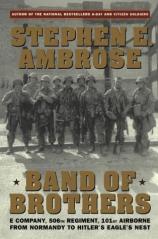Band of Brothers
Review
Band of Brothers
BAND OF BROTHERS is the history of Easy Company, 506th Parachute
Infantry Regiment, 101st Airborne Division, from basic training to
D-Day. It follows the jump into Holland, the Battle of
the Bulge, and finally the occupation of Berchtesgaden and Austria.
This is a rarity among military histories, told from the viewpoint
of the front line soldier, the privates, non-coms and officers who
carry out the grand strategy of generals. Many books
discuss the inner working of commands at Division and Army levels,
but few detail the day to day life of the
soldier. Stephen Ambrose's book does that and
more. It explores the how draftee citizen soldiers of
elite outfits like the 101st Airborne did, in World War II, defeat
an enemy like the well trained German Wehrmach and S.S.
In 1942 the Second Battalion of the 506th was formed and started
basic training. The recruits volunteered for the thrill,
the honor, the extra money, but above all the desire to be better
than the ordinary draftee. A description of the physical effort
required in basic training explains why a majority of the
volunteers never made it as far as the door of the airplane. When
the Company finally made it to Fort Benning for jump school, they
were in such great physical shape that they outdid the school's
physical fitness cadre. After five jumps in December of
1942, the company qualified as Parachutists, and nine month later
they were on a ship to England to train for the invasion of
Hitler's Fortress Europa.
Ambrose also details the nine months of training that the company
endured England in preparation for the invasion. He
tells it from the viewpoint of both officers and men and explains
the final shift in Easy Company hierarchy just prior to D-Day. His
description of the night jump of the 101st in the early morning
hours of June 6, 1944, with men and officers strewn about the
countryside, and the confusion, heroism and chaos that surrounded
the successful landings at Utah Beach, is masterful. He
explains how the few outer roads from the beach are zeroed in by
German artillery, and that the job of the airborne was to nullify
the artillery and its defending troops.
The efforts of Lt. Richard Winters to fulfill that mission are one
of the high points of the book. As the book reports "By
this time, about 0700, E Company consisted of two light
machine-guns, one bazooka (no ammunition), one 60mm mortar, nine
rifleman, and two officers." Lt. Winters was in charge. With less
than 100 men assembled in the battalion, its Commander could only
afford to send Easy Company to attack and overrun a four gun German
battery defended by a fifty man platoon. As the book puts it,
quoting one of the men, "Here the training paid off. `We fought as
a team without standout stars,' Lipton said. `We were like a
machine. We didn't have anyone who leaped up and charged a
machine-gun. We knocked it out or made it withdraw by
maneuver and teamwork or mortar fire. We were smart;
there weren't many flashy heroics. We had learned that heroics was
the way to get killed without getting the job done, and getting the
job done was more important.`" Three hours after the attack
commenced, it was completed successfully.
Easy Company went on to fight through Normandy until June 29th when
it was pulled out of line and sent to a field camp near Utah
Beach. They had jumped into Normandy with an effective
strength of 139 men and officers and ended up with
79. Ambrose's description of those few days from the
night jump to their last fight at Caretan is magnificent.
The book next describes the Company's jump into Holland, near the
Rhine River, where they fought through November of 1944, and then
on to Bastogne, to again become front line troops in the historic
Battle of the Bulge. Easy Company was the first Allied
troops to occupy Hitler's mountain retreat at
Berchtesgaden. After occupation duty in Austria, the
company and battalion were sent back to a small town near Paris,
and on November 30, 1945, the 101st was deactivated. As Ambrose
puts it, "The Company had been born in July 1942 at
Toccoa. Its existence essentially came to an end almost
exactly three years later..... In those three years the men had
seen more, endured more and contributed more than most men can see,
endure or contribute in a lifetime." BAND OF BROTHERS
describes those eventful three years in such a way as to make the
reader experience them too.
Reviewed by John Kless on January 21, 2011
Band of Brothers
- Publication Date: June 6, 2001
- Genres: History, Nonfiction
- Paperback: 336 pages
- Publisher: Simon & Schuster
- ISBN-10: 0743216458
- ISBN-13: 9780743216456





